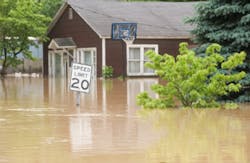Many people rarely think about disinfecting water before drinking it. Water flowing out of a tap or a plastic bottle carries with it the assumption that it has been disinfected at some point in its journey. Those with water wells and water treatment professionals surely think about water disinfection much more often, and the state-of-the-art technologies such as ozone, UV light and reverse osmosis filters that make it relatively easy today.
In an emergency situation, however, none of the usual assumptions about our water hold up. Municipal and well water can both be easily contaminated in a disaster, and the relied-upon technologies of everyday water disinfection are often unavailable, inadequate or compromised themselves.
The lack of potable water makes it quickly obvious how dependent we are on it in everyday life, using it for cooking, hygiene, cleaning and of course drinking. In an emergency situation these needs will be increasingly apparent. If the weather is extremely hot or if you become ill, by drinking contaminated water for example, you will become even more dependent on water to prevent dehydration.
Although having a two week supply of bottled water, at least one gallon per person per day, stored for an emergency is recommended, there are three main processes recommended by FEMA, the Red Cross, and the EPA to treat contaminated water if you must do so: Chlorination, boiling and distillation.
There are five primary categories of contaminants that can be in water: Particulates, biological, inorganic, radioactive and organic. Biological contaminants, including bacteria, parasites and viruses, are usually much more dangerous than the other types of contaminants.
Filters are not recommended during an emergency because they only provide variable protection and some filters, including RO filters, can become a breeding ground for bacteria. Also, failed filters give no indication, leaving your water vulnerable to any contaminants. The same goes for UV and ozone treatment, however, all of these methods are fine to use as a first barrier to contaminants before boiling, distilling or chlorinating the water.
The very best solution for treating possibly contaminated water is often a combination of the three methods.
Boiling water kills biological contaminants in water but does not remove them or the endotoxins created when they die, and boiling can concentrate other contaminants such as heavy metals. But boiling is also the simplest and safest disinfection method; water must only be boiled for one minute and cooled before drinking.
Chlorination kills biological contaminants in water but does not remove the dead biological contaminants or other contaminants. Bleaches that are scented, color safe or contain added cleaners are not safe for this. Add 16 drops (1/8 teaspoon) of bleach per gallon of water, stir and let stand for 30 minutes. There should be a slight bleach odor.
Distillation is the only process that kills and removes biological contaminants and also protects against a broad-spectrum of other contaminants. It can also desalinate ocean water. Distillation involves boiling water and collecting the vapor that condenses back to water. Precise instructions for distillation can be found here: http://www.fema.gov/pdf/library/f&web.pdf.
Information from the following sources is included in this article:
Water Technology, October 2013: Understanding water safety during an emergency: Part one
Water Technology, November 2013: Understanding water safety during an emergency: Part two
The Federal Emergency Management Agency and Red Cross recommendations for emergency water treatment: http://www.fema.gov/pdf/library/f&web.pdf.
The U.S. Environmental Protection Agency Emergency Disinfection of Drinking Water: http://water.epa.gov/drink/emerprep/emergencydisinfection.cfm.
